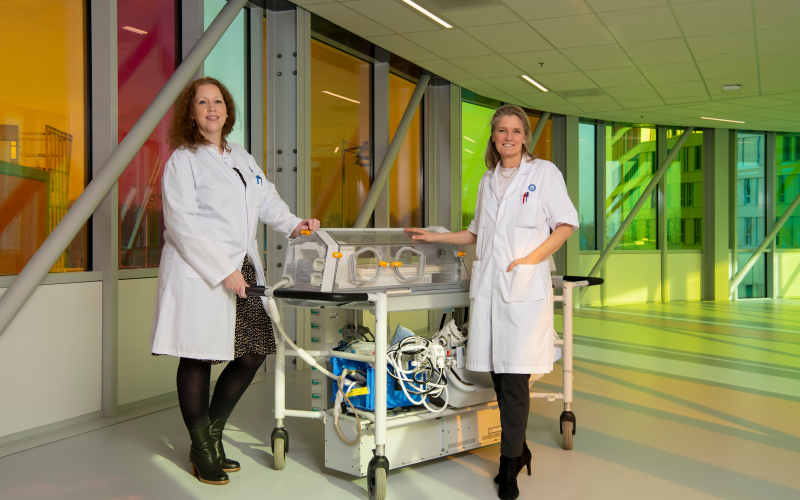Suzanne had made plans for a natural birth at home. But things didn’t go as planned. After a regular check-up, the doctor sent her for an emergency delivery to the hospital, where her daughter Senna was born within an hour. Instead of resting directly on her mother chest, “the medical team urgently took her out of the room,” recalls her father Sebastian. “She couldn’t breathe independently, so she was put on a ventilator.” One day later, doctors told the couple that Senna had suffered a severe brain infarct, and prepared them for the worst. “We were told that our child would be physically disabled and given her situation, they could not give us the assurance that she would even survive,” Sebastian said. The team of doctors gave Sebastian and Suzanne a choice; their daughter was eligible to be enrolled in an experimental treatment at the University Medical Center (UMC) Utrecht that uses stem cell therapy to repair the brain of a newborn baby after a brain infarction.
“The results of the study are promising for patients. “
Stem cell therapy: stimulating the brain’s own healing power
The therapy in question, which is conducted at the Wilhelmina Children’s Hospital, part of the UMC Utrecht, might be a breakthrough in repairing brain damage in newborns, something for which there’s currently no other clinical solution available. The treatment consists of administrating stem cells to the affected areas of the brain with the aim of regenerating damaged tissue. Neuroscientist Cora Nijboer, who led the pre-clinical research, explains: “It is known that mesenchymal stem cells (MSCs), by secreting all kinds of good substances, contribute to suppress the inflammatory response in the brain and stimulate the brain’s own stem cells to repair damage. When we treated newborn mice with brain damage with MSCs, we discovered that both the amount of brain tissue lost and the animals’ impairments were reduced drastically. We just needed to find a way to safely administer these stem cells to babies together with the clinical team.”
The use of intranasal drops proved to be a good way to get the stem cells to travel speedily from the nose to the brain, where they are needed. “The part of the brain that is injured releases a lot of signals as to indicate ‘here is the damage’, so that the stem cells ‘know’ exactly where to go. That’s reassuring, because now we know stem cells will only travel where the lesion is,” Nijboer explains. “More than that, we saw that the transplanted MSCs disappeared from the brain after just a few days, indicating that it is not the transplanted MSCs, but rather the brain’s own stem cells (activated by the good substances of the MSCs) that repair the injury and develop into new tissue. And that probably makes it safer for the patient.”

Researchers Cora Nijboer (on the left) and Manon Benders (on the right) standing next to an incubator at UMC Utrecht:. Photo: Ilco Kemmere
Treatment finally reaches patients
After more than ten years of research, dutiful ethical approvals and much patience, Nijboer and the clinical team have finally brought the treatment to patients. Ten newborns who were transferred from hospitals across the Netherlands after suffering a cerebral infarct have participated in the study so far. Senna, the daughter of Suzanne and Sebastian, is one of them.
Suzanne says the decision to take part in this feasibility and safety study was not easy: “My first thought was, ‘Ok, if we can do anything about it, we should do it.’ But after reading that it was an experimental study, I thought, ‘Oh! Is it safe and what are the risks?’,” she recounts. In those frenetic 48 hours after the hurried birth, Suzanne had come to embrace the possibility that Senna might have motor or mental disabilities for the rest of her life. “I could accept almost anything; I would love her either way. But I could not accept putting my child at risk.” Sebastian adds: “We couldn’t accept losing her.”
“We are glad that we can contribute to the further development of this stem cell therapy.”
The couple, who had to take a decision within a week, spoke with neonatologist Manon Benders, who works closely with Nijboer’s research group and leads together with other pediatricians/neonatologists the clinical part in the study. “She explained to us which parts of the brain were affected and what the possible effects could be,” says Sebastian. Meanwhile, Senna’s parents are extremely happy that they decided to participate. “We don’t know if it’s because of the treatment, but Senna is doing so well! She is happy, alert and always smiling,” says Suzanne. “We are glad that we can contribute to the further development of this promising stem cell therapy and, by sharing our experience, help other parents who may go through the same,” adds Sebastian.
Stem cell therapy holds potential for other types of damage
Because administering stem cells via nasal drops seems safe and feasible so far, it means that this therapy might also be used for other newborn patient groups, for example for children who are born (extremely) prematurely or babies with a severe shortness of oxygen around birth. In the future, stem cell therapy could even help repair children’s damaged lungs or intestines.
As befits a good scientist, Nijboer is cautiously optimistic: “It is still too early to say anything definite.” But the results, she admits, are promising for patients. “Because stem cell therapy has the potential to repair brain damage, rather than just limit it.”
More information
Research: Perinatal Arterial Stroke Treated With Stromal Cells Intranasally
This is but one example of how we are working with families on novel interventions to predict, treat and eventually prevent the lifelong consequences many children still face after a tough start.
Read also Beyond Survival.

